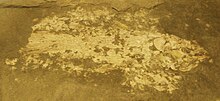Ticinepomis
| Ticinepomis Temporal range: Lower Ladinian,
| |
|---|---|

| |
| Fossil | |

| |
| Reconstruction | |
| Scientific classification | |
| Domain: | Eukaryota |
| Kingdom: | Animalia |
| Phylum: | Chordata |
| Clade: | Sarcopterygii |
| Class: | Actinistia |
| Order: | Coelacanthiformes |
| Family: | Latimeriidae |
| Genus: | †Ticinepomis Rieppel, 1980 |
| Type species | |
| †Ticinepomis peyeri Rieppel, 1980
| |
| Other species | |
| |

Ticinepomis is an extinct genus of coelacanth lobe-finned fish which lived during the Middle Triassic period in what is now Switzerland. It contains two species, T. peyeri and T. ducanensis.[2]
Specimens of the species T. peyeri, which was named after Bernhard Peyer, are most common in the Besano Formation (or Grenzbitumenzone) of Monte San Giorgio in canton Ticino.[3] Other coelacanths from Monte San Giorgio include a larger species (tentatively referred to Holophagus picenus) from the Besano Formation,[4] and a species of Heptanema from the Meride Limestone.[5]
Larger Ticinepomis specimens have been found in the Prosanto Formation of canton Graubünden, originally referred to as Ticinepomis cf. T. peyeri.[6] A revision showed that this material belongs to a new species, T. ducanensis, remains of which were also discovered in the Besano Formation of canton Ticino.[2] The Prosanto Formation also produced the unusual coelacanths Foreyia and Rieppelia.
Classification
Ticinepomis was originally described as being a member of the family Coelacanthidae, being similar to Coelacanthus, Holophagus and Undina.[3] Later, T. peyeri was placed in Latimeriidae.[6] The bizarre Prosanto Formation latimeriid Foreyia is thought to be T. peyeri's closest relative, as they share many features despite their drastically contrasting appearances.[7]
References
- ^ Scheyer, Torsten M.; Romano, Carlo; Jenks, Jim; Bucher, Hugo (2014). "Early Triassic Marine Biotic Recovery: The Predators' Perspective"". PLOS ONE. 9 (3): e88987. Bibcode:2014PLoSO...988987S. doi:10.1371/journal.pone.0088987. PMC 3960099. PMID 24647136.
- ^ a b Ferrante, Christophe; Furrer, Heinz; Martini, Rossana; Cavin, Lionel (2023). "Revision of the Middle Triassic coelacanth Ticinepomis Rieppel 1980 (Actinistia, Latimeriidae) with paleobiological and paleoecological considerations". Swiss Journal of Palaeontology. 142 (18): 18. doi:10.1186/s13358-023-00276-4. PMC 10495523. PMID 37706074.
- ^ a b Rieppel, O. (1980). "A new coelacanth from the Middle Triassic of Monte San Giorgio, Switzerland". Eclogae Geologicae Helvetiae. 73 (3): 921–939.
- ^ Rieppel, Olivier (1985). "A second actinistian from the Middle Triassic of Monte San Giorgio, Kanton Tessin, Switzerland". Eclogae Geologicae Helvetiae. 78: 707–713. doi:10.5169/seals-165676.
- ^ Renesto, Silvio; Stockar, Rudolf (2018). "FIRST RECORD OF A COELACANTH FISH FROM THE MIDDLE TRIASSIC MERIDE LIMESTONE OF MONTE SAN GIORGIO (CANTON TICINO, SWITZERLAND)" (PDF). Rivista Italiana di Paleontologia e Stratigrafia. 124 (3). doi:10.13130/2039-4942/10771. ISSN 2039-4942.
- ^ a b Cavin, Lionel; Furrer, H.; Obrist, C. (2013). "New coelacanth material from the Middle Triassic of eastern Switzerland, and comments on the taxic diversity of actinistans". Swiss Journal of Geosciences. 106 (2): 161–177. doi:10.1007/s00015-013-0143-7. S2CID 140189669.
- ^ Cavin, L.; Mennecart, B.; Obrist, C.; Costeur, L.; Furrer, H. (2017). "Heterochronic evolution explains novel body shape in a Triassic coelacanth from Switzerland". Scientific Reports. 7 (1): 13695. Bibcode:2017NatSR...713695C. doi:10.1038/s41598-017-13796-0. PMC 5651877. PMID 29057913.





